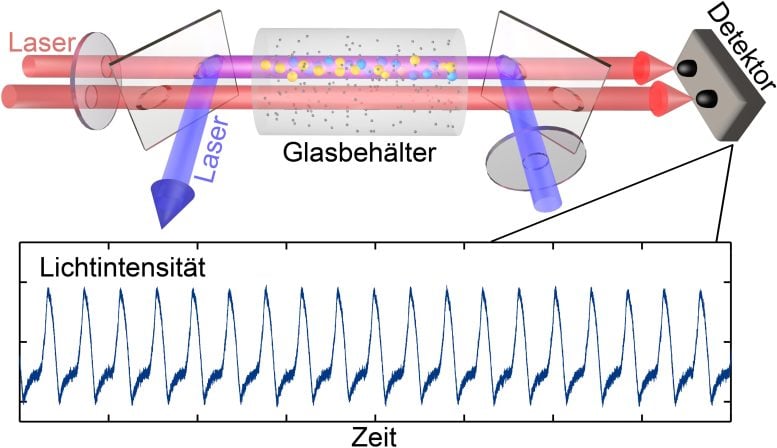A Rydberg atom has an electron that is far from the nucleus. Credit: TU Wien
Scientists have created an extremely exotic state of matter. Its atoms are hundreds of times larger in diameter than usual.
Time crystals, originally proposed by Nobel laureate Frank Wilczek in 2012, have now been successfully created using Rydberg atoms and laser light at Tsinghua University in China, with theoretical support from TU Wien in Austria. This new state of matter does not repeat itself in space like traditional crystals, but in time, displaying spontaneous periodic rhythms without external stimulus, a phenomenon known as spontaneous symmetry breaking.
A crystal is an arrangement of atoms that repeats itself in space at regular intervals: At every point, the crystal looks exactly the same. In 2012, Nobel laureate Frank Wilczek asked the question: Could there also be a time crystal – an object that does not repeat itself in space, but in time? And could it be possible for a periodic rhythm to emerge even though there is no specific rhythm imposed on the system and the interaction between the particles is completely independent of time?
Frank Wilczko’s idea has stirred up a lot of controversy over the years. Some considered time crystals impossible in principle, others tried to find loopholes and realize time crystals under certain special conditions. Now, a particularly spectacular kind of time crystal has been successfully created at Tsinghua University in China with the support of TU Wien in Austria. The team used laser light and very special types of atoms, namely Rydberg atoms, with diameters several hundred times larger than normal. The results have now been published in the journal Natural physics.
Spontaneous breaking of symmetry
A ticking clock is also an example of time-periodic motion. But it doesn’t happen by itself: Someone had to wind the clock and start it at a certain time. This initial time then determined the timing of the ticks. It is different with the time crystal: according to Wilczek’s idea, the periodicity should arise spontaneously, although in reality there is no physical difference between different points in time.
“The frequency of the ticking is predetermined by the physical properties of the system, but the times when the ticking occurs are completely random; this is known as spontaneous symmetry breaking,” explains Professor Thomas Pohl from the Institute of Theoretical Physics at TU Wien.

A static system with a continuous light supply leads to time-dependent periodic signals. Credit: TU Wien
Thomas Pohl was in charge of the theoretical part of the research work that has now led to the discovery of the time crystal at Tsinghua University in China: Laser light was shone into a glass container filled with a gas of rubidium atoms. The strength of the light signal that arrived at the other end of the container was measured.
“It’s actually a static experiment in which no specific rhythm is imposed on the system,” says Thomas Pohl. “The interactions between light and atoms are always the same, the laser beam has a constant intensity. But surprisingly, it turns out that the intensity that reaches the other end of the glass cell begins to oscillate in very regular patterns.”
Giant atoms
The key to the experiment was to prepare the atoms in a special way: Electrons an atom they can orbit the nucleus in different orbits depending on how much energy they have. If energy is added to an atom’s outermost electron, its distance from the atomic nucleus can become very large. In extreme cases, it can be several hundred times farther from the core than usual. This creates atoms with a giant electron shell – so-called Rydberg atoms.
“If the atoms in our glass container are prepared in such Rydberg states and their diameter is huge, then the forces between these atoms also become very large,” explains Thomas Pohl. “And that in turn changes the way they interact with the laser.” If you choose the laser light in such a way that it can excite two different Rydberg states in each atom at the same time, then a feedback loop is created that causes spontaneous oscillations between the two atomic states. This in turn leads to oscillatory absorption of light.” The giant atoms oscillate on their own into a regular rhythm, and this rhythm is translated into a rhythm of light intensity arriving at the end of the glass container.
“We have created a new system here that provides a powerful platform for advancing our understanding of the time crystal phenomenon in a way that is very close to Frank Wilczko’s original idea,” says Thomas Pohl. “Precise, self-acting oscillations could be used for sensors, for example. Giant atoms with Rydberg states have already been successfully used in other contexts for such techniques.”
Link: “Dissipative time crystal in a strongly interacting Rydberg gas” by Xiaoling Wu, Zhuqing Wang, Fan Yang, Ruochen Gao, Chao Liang, Meng Khoon Tey, Xiangliang Li, Thomas Pohl, and Li You, 2 July 2024, Natural physics.
DOI: 10.1038/s41567-024-02542-9